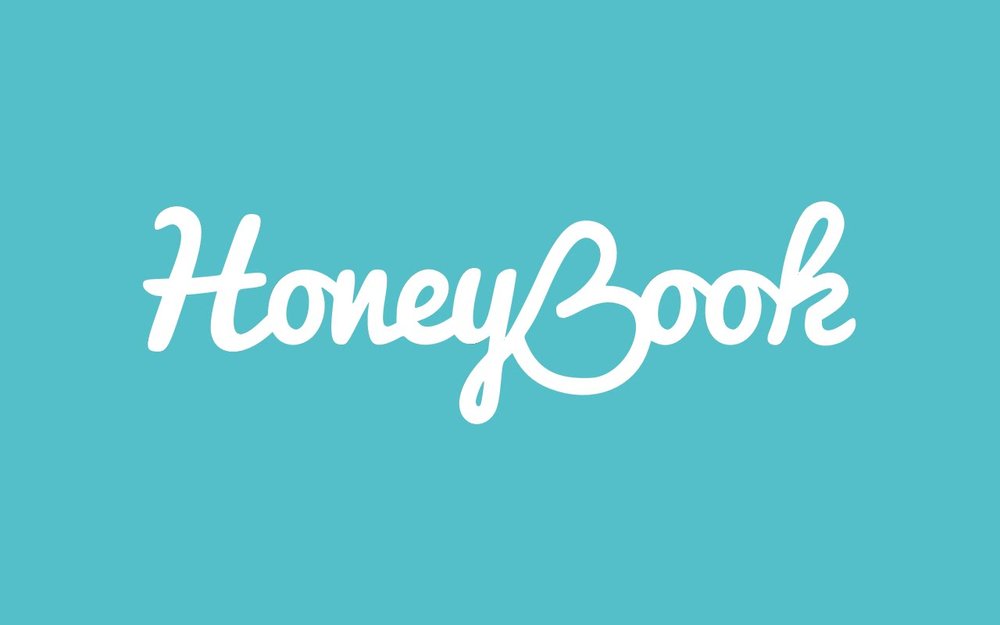Affiliate Disclaimer
Before we dive into our review, in the name of transparency, we would like to inform you that we will be utilizing affiliate links to Honeybook throughout this post. Using these links come at no additional cost to you (you can actually save 50% off your first year’s subscription cost!), and we receive a commission from your purchase cost. Please note as well, that while we do link to other products and services in this post for reference, these are not referral links as our exposure to them is limited or not satisfactory enough to recommend to our audience.
A Real User’s Guide to Getting the Most Out of Honeybook
Honeybook is a really popular CRM (customer relationship management) tool that gets a lot of use by creatives – particularly those working in or around the wedding and event planning space.
We were quickly attracted to Honeybook after seeing some mentions about it in a few Facebook groups as a way to send out invoices, contracts, and generally have more control over the work we do for our clients. We ended up signing up for the free trial, and while initially we struggled to adapt to all it had to offer as it can be a bit daunting to newbies, in the end we have been using it successfully and happily for 2 years now and will continue to do so.
In addition to testing out Honeybook, we also looked into a number of Honeybook competitors such as 17hats, Tave, and Dubsado. We’re not going to inexplicably dock any of those CRM platforms, as they all have their merits based on our experience. With all of the exposure to these different platforms, though, it has provided us some great background knowledge for points of comparison – and ultimately really showcases our passion for using Honeybook vs. other options available on the market.
Most products we purchase we do so for a specific reason.
We’re not the types to just throw our money at something with the hopes it will work for us.
We do a lot of research into the things we buy, and when the opportunity presents itself – we like to give things a test run. With most software, a free demo period is pretty much the norm for any product worth buying- as it shows that the creator(s) have faith their product will sit well with consumers once they’ve had a chance to use it.
If you need a detailed review of Honeybook, check out our review over on our new website – Formed From Light!
Why we needed a crm platform like honeybook

Before we get into the meat of walking through Honeybook with you, and showcasing how we use it as a part of our photography business’ workflow – we wanted to take just a few moments to talk about why this was a product we needed.
Like many small business owners who begin to find success in their market, whether it be photography, event planning, or the like, there comes a point where scaling the business requires making investments into tools that will help make things easier.
Now, what is easy takes many forms, but for our purpose we take the approach to “work smarter, not harder” when possible. Or, well, just work harder at other areas of the business that require it!
Finding products and services that can make life a little easier is great, as this directly impacts the customer experience, too.
While Honeybook, and other CRM platforms, offer value to you as a business owner – this value is passed on to your clients. While it may not always be recognizable, they are happy to have an easy process to book with you as opposed to go through some challenging booking process that other vendors might put them through.
In our own experience, when we sit down and show prospective clients what our booking process looks like – we are often met with “wow”, because they have very likely met with other photographers who do things with pen-and-paper and take payments only by cash or check.
While the earliest days of our photography business began with us doing just that, it was not sustainable.
Honestly, it was even a little embarrassing to force our prospective clients to meet up to sign a contract and make a payment.
CRM services provide a suite of tools to help manage the client-business relationship.
The specific tools this is comprised of depends on the service, but as a rule of thumb you can often expect the following:
-
Contracts
-
Invoicing
-
Bookkeeping
-
Messaging
-
Scheduling
If it’s not obvious, these are all core things we needed in order to run our business more successfully.
Our vision of success includes being able to have more time to ourselves (ie: not wasting time doing silly things), as well as making our client’s happier by not wasting their time, either.
With a CRM suite like Honeybook, we are able to save our own time & save our clients time by simplifying processes that would otherwise be very tedious to perform.
With this background in mind, let’s talk a little more about what Honeybook offers us as business owners – and how these tools end up pleasing our clients and prospective clients.
A High Overview of honeybook’s features
Honeybook is fundamentally a project management tool.
It is an ideal solution for small business owners working in the wedding and event space.
Though we are photographers ourselves, it’s easy to see how this tool could be leveraged by other service providers such as event planners, caterers, DJs, bands, and so on. Needless to say, most of the features we will be covering have applicability to you – regardless of what product or service you are specifically offering.
the core features of honeybook
Honeybook has a lot of great features – many of which we use on a daily basis now. There are a few smaller features that are really “add ons” as opposed to reasons why you would want to purchase a service platform like this, and we’ll talk about those in more depth later on in this article.
For now, let’s talk about the main components of Honeybook – you know, the things that really allow Honeybook to sell itself as a project management tool.
1). Create and send contracts to clients

The first thing we knew we needed to do was revamp our contract signing process. Having people sign with pen-and-paper is a dated way of doing things. It is borderline impossible to maintain as photographers that travel as well. There is no way I’m driving 2 hours to Philadelphia just to have someone sign a contract, much less flying across the country. Sure, this could be done by mail, but have you seen how slow the mail is?
Before Honeybook, we had used Docusign with a free trial period. While an okay service, it is extremely limited in that it is intended only for preparing, sending, and having contracts signed in a digital format. It is a fine product if this is all you need, but again, as a small business owner – we needed more in our software to accommodate for other things we are doing.
Later on in this post, we will walk you through how we create and send contracts ourselves, but for now just keep in mind – it is a simple process, and can integrate a number of automations that make setting up a contract for a new client and sending even easier.
2). Easy invoicing
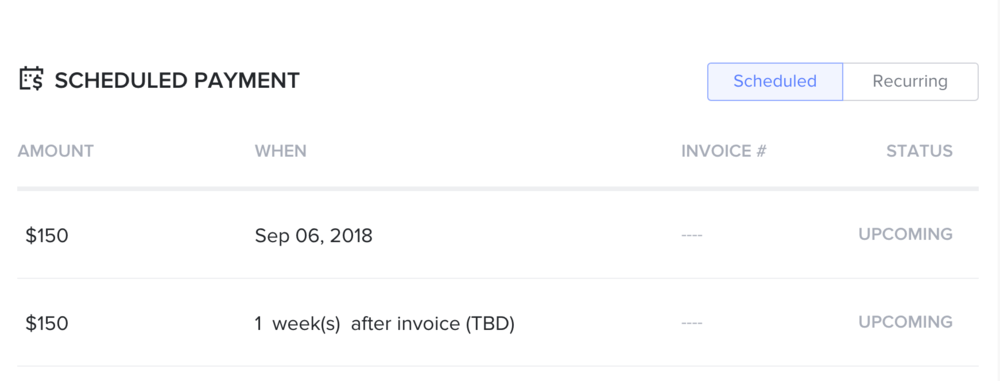
Sending an invoice is a lot easier than needing to collect a check. While we do technically prefer checks and cash on the occasion where we receive these – because there are no transaction fees – the reality is the 1.5% (for debit) and 3% (for credit) fees are worth the time saved and convenience. This is especially on the side of the consumer, who can just checkout for our photography service in the same way that they might buy something virtually anywhere online.
Our invoices through Honeybook have been customized with our company’s logo and other details, and can be laid out to break down the costs of a particular service and stored in the form of a template for future reference. Nice and easy!
As of September 2018, Honeybook also released an update into the payment scheduling system that enables you to setup recurring payments options for your clients. This is great news for people who have long term projects and need to consistently send invoices to your clients
3). Project Management Queues

Coming from an IT space, using a platform like JIRA to move tasks from one queue to the next to indicate where it is in the process of opening, working on, and completion is a valuable component of Honeybook we use frequently.
These queues are mostly customizable, and in our context it makes it a lot easier to track where we are with a particular client & overall. We’ve included a screenshot above of part of our queue for reference.
4). Systemic Lead Collection
Honeybook, when used to it’s fullest, can be integrated with your website through the use of a customizable contact form. Embedded on your site’s contact page, all of the information about a prospective client can be pulled right into Honeybook for you – and with some advance use, can be automated to send an instant response to this message and enable you to bring the conversation into HB’s messaging system.
Looking back at the queues, these new leads will generate in as an “Inquiry,” and your response can enable you to go from 0 to 60 in terms of booking your client – all while already exposing them to the software they will be interacting with consistently to speak with you, sign a contract, make payments, etc.
Our workflow & where honeybook fits into it
Now that you are able to see some of the main features of Honeybook, we want to share with you our normal daily workflow and where Honeybook fits into it.
Generally speaking, we use most of the features Honeybook has to offer – though have not gone super deep into some of the more advanced automation techniques yet as we’ve not found it to be necessary for our particular workflow.
As it is, let’s talk about our normal process for communicating with and onboarding a new client into our photography service:
-
We receive an inquiry via our website’s Contact form into our email (we use Outlook for this)
-
The inquiry response is handled via email and normally within 1-2 emails we setup a phone call
-
Once the phone call is concluded and a couple decides to book with us, we load their details into Honeybook when we prepare a “Proposal” (a combo of the contract and invoice schedule)
-
The details include name, phone number, lead source, etc. – most of which become fields that can be setup to generate directly into the contract/invoice depending on how you set up the template
-
We then update the invoice/contract template to include specific details of this client. If the client is not changing anything in the base package, we don’t have to do anything in this part!
-
From there, it’s a simple as sending it over to the client using Honeybook’s built in mailing system
-
Once the client receives it, we receive emails indicating when it was viewed, contract signed, invoice paid, etc.
As you can see, this is not a complicated workflow at all – and Honeybook helps streamline the process for us. Further areas of automation could certainly be added, but due to the volume of clients we book, this hasn’t been necessary (yet).
One of our future plans is to integrate our wedding guide into an automated message to be sent once the contract is signed and first payment made, something we currently sound out by hand.
As services move along for a client, we will revisit Honeybook on multiple occasions.
When we complete an engagement session, for example, we’ll move our clients file to the “Wedding Day Planning” queue we set up.
This becomes a quick and easy visual reminder that – we have a client that is planning their wedding, and we’ve already fulfilled the engagement session requirement for them.
Maybe not useful if you only have 5 clients, which might be manageable even just in your mind, but if you are like us and have 30+ active projects – it becomes a little more challenging, and more necessary to have a tool like this available to us!
Another common thing we use is sending an additional invoice (often for travel expenses that arise after the initial signing). This can be quickly setup, and associated with a specific client file for easy reference.
breaking down how honeybook can work for you

Now that you can see into our personal workflow that integrates many of Honeybook’s features, we want to further break down all that Honeybook has to offer – and how you can use it yourself.
But, before we begin!
Have any questions about Honeybook? Ask away in the comments at the end of this post!
Now, let’s get on to discussing in more depth Honeybook’s features:
1). Create templates for contracts and invoices (and everything else!)
Before you really begin to use Honeybook as a part of your business workflow, you will need to setup templates for your contracts and invoices. Early on into starting with Honeybook, they have a concierge service that can actually do this for you too – based on details you supply them. This can, without a doubt, take away some of the learning curve that would come for a user who ignores this option.
We’ve included a snapshot of the first section of one of our proposals for reference below – where you can see a breakdown of items associated with our wedding package. When sending a Proposal, your client would be exposed to this, the invoice schedule (“Payment Plan”) and the Contract. As you can see, this is customized with our own imagery – and has a very professional look. Everything is clear and easy to adjust.

On the Contract end of things, it is essentially a large text box (similar to what would be used when writing a blog post). There is no stock verbiage that comes included, so you will need to put together your own contract or work with a lawyer to draft a contract suitable for your business needs. You may also go the route of using LegalZoom or a similar platform for this. The very end of the document are the signature spaces, which allow you and your client to sign the contract virtually with the click of a button.
You can also create templates for a load of other features in Honeybook such as: questionnaires, brochures, packages, contact forms, emails, email signatures.
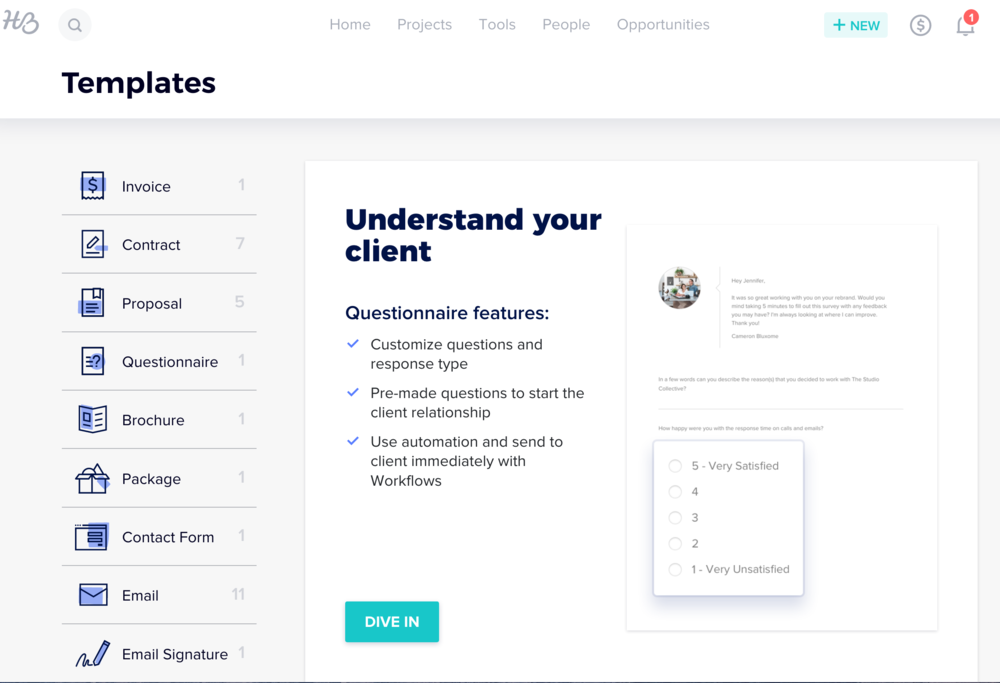
2). Customize the project management pipeline

We talked about the Honeybook queue system earlier in this article. As you can see in the above image, the option to customize these queues is a pretty simple but significant feature that makes keeping on top of your work easy.
Some queues are standard and can not be changed, but most of these make sense to be standard regardless of your industry (such as the queue for when the Proposal is signed and Retainer Paid). All other queues are up to you to define. We have broken this down for our business quite nicely with the following setup:
-
All Active Projects
-
Inquiry
-
Proposal Sent
-
Proposal Signed
-
Retainer Paid
-
Meeting
-
Engagement Planning
-
Engagement Editing
-
Engagement Complete
-
Wedding Day Planning
-
Wedding Day Editing
-
Wedding Day Complete
-
“Day After” Planning
-
“Day After” Editing
-
“Day After” Complete
-
Completed
-
Archived
There is a logical flow of our work pipeline. We suggest you set yours up in a similar fashion!
Also, we have to say that, in a weird way, it is fun to be able to move client’s projects through these steps. 🙂
3). light bookkeeping
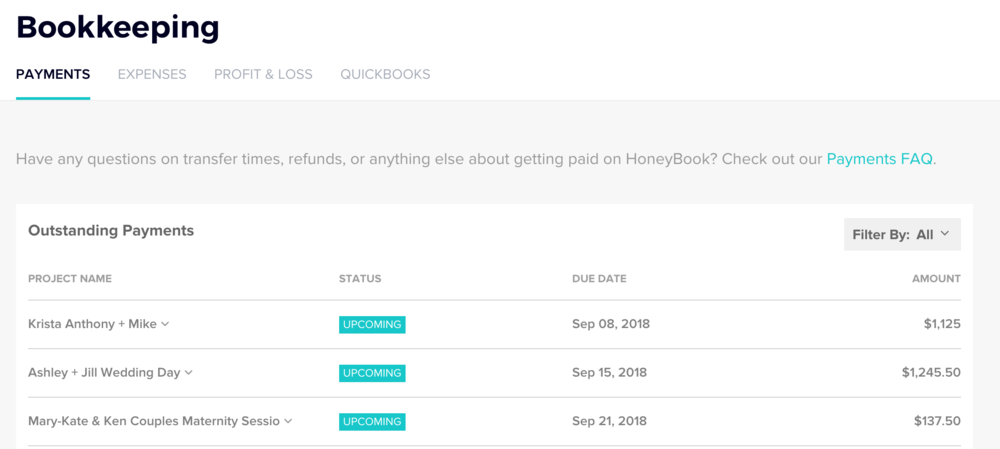
Honeybook’s Bookkeeping features are actually fairly new.
They were not in place (at least – not how they are today) when we originally invested into this CRM platform.
This is actually a unique feature about products like this that take an “as a service” approach, and charge a monthly/annual fee for use. Honeybook as a product has advanced over time, and we expect the future is positive given the current state of the platform is very good.
The built in bookkeeping feature is nice, but also quite limited. If you are planning to do all your accounting in Honeybook, this is not the platform for you. This is something we do ourselves separately with a Microsoft Excel spreadsheet, and we know many others use platforms like Quickbooks to streamline this further.
The use of Honeybook’s Bookkeeping section boils down to having information regarding expected payments coming up, who has paid, who is overdue on payment, etc. in a quick and simple manner. You can also track Expenses and look at your Profit & Loss statements by time period, though we’ve never had a need for these features ourselves.
4). auto-updating calendar based on your projects
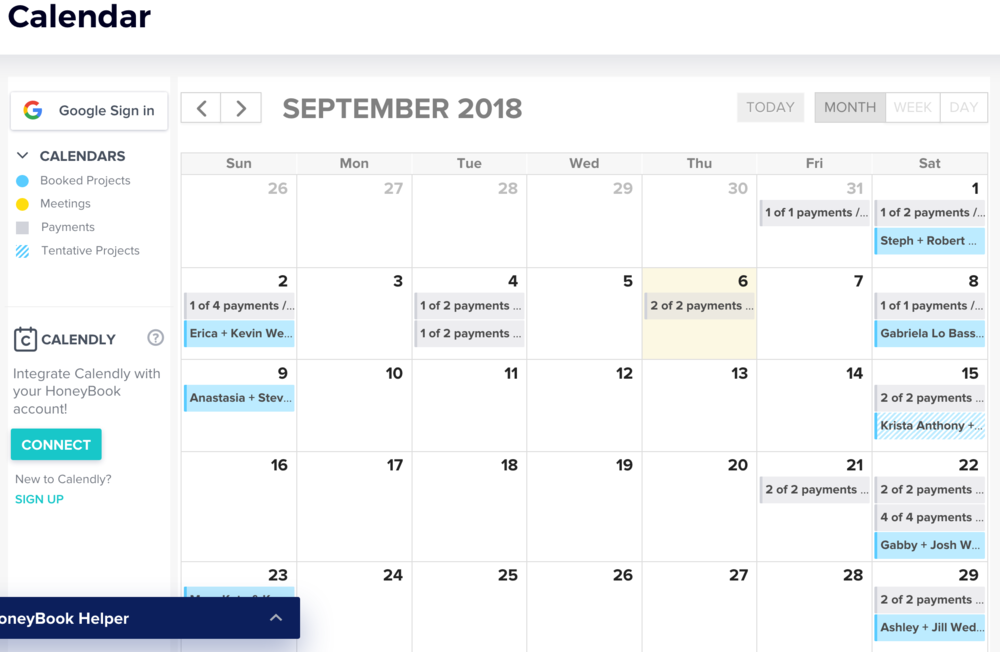
The calendar feature built into Honeybook is actually quite useful – especially for seeing when payments are due. When you set up your projects with a new client, the date will become blocked off with the project name. In our case, these are mostly wedding dates. The option exists to update the calendar manually as well, to accommodate for anything else you’d want to track on a calendar not booked through the system.
If you are using it, you can also integrate Calendly with your Honeybook account.
5). customizable contact form integration into your website
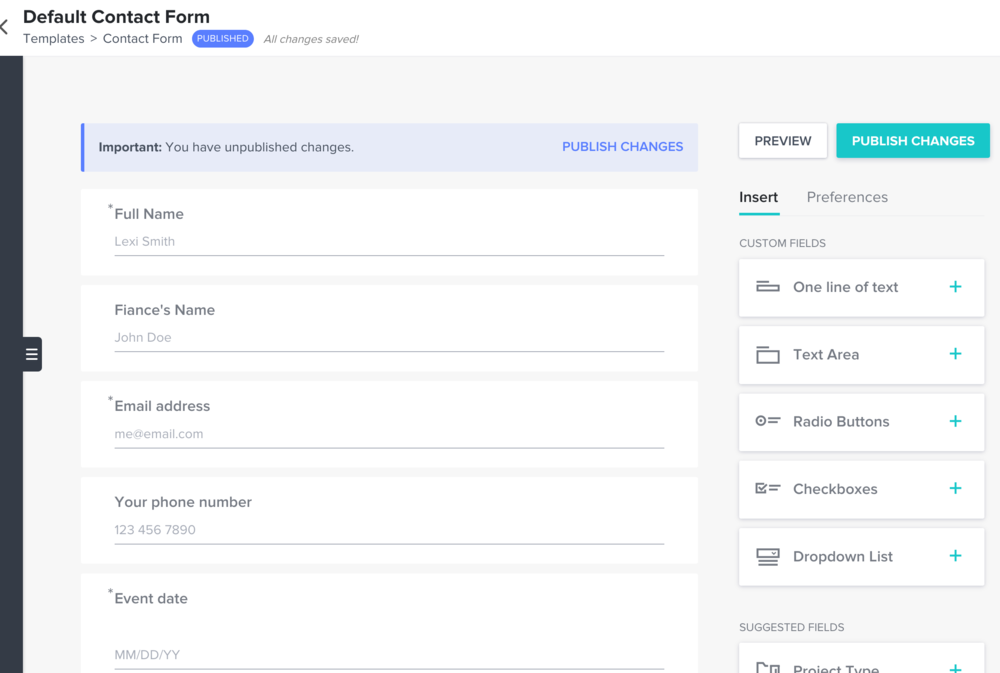
The Contact Form in Honeybook is one of the more interesting “unexpected” features.
First off, you can customize this form to your liking. This is done both in terms of the actual fields you add, as well as the color scheme.
Integrating into your web site is also as simple as embedding some code onto your contact page (or any other page you want a contact form). One of the great uses of this is to have multiple contact forms to integrate into different pages, which could align with the specific audience that might be visiting that page.
For example, you could add a contact form to a Family Photography Session pricing page – customized to target an audience with questions specifically that would be needed for quickly booking a family session. Another contact form could be used on a wedding investment page, probably asking more questions to get a sense of where, when, and who is getting married.
6). build your workflows
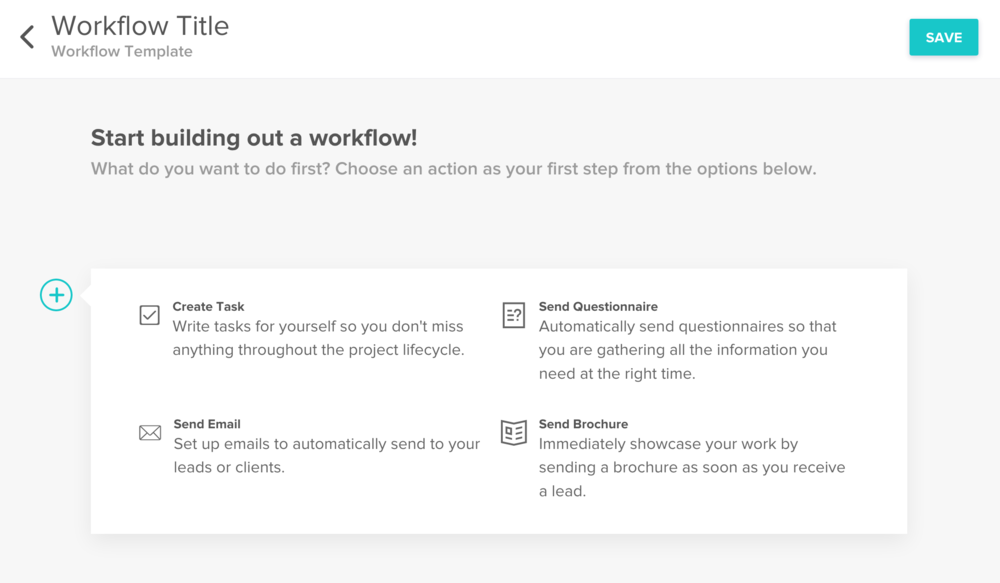
Setting up workflows in Honeybook is pretty easy, and has the potential to really shave time off of your work day. You can setup workflows to handle sending automated emails, questionnaires, brochures, etc.
As wedding photographers, easy areas where we could integrate workflow automation is in sending our wedding guide once they sign and pay the retainer for their wedding. A month in advance of the wedding project date, we could automate a message to be sent to fill out the questionnaire. These are easy tasks that don’t take too much time to do on their own, but when done across many clients – the time adds up. Not to mention, it can sometimes be difficult to remember to do all of these things.
With workflow automation, you don’t have to worry about ever forgetting to do these things again – and can “wow” your client by having certain things done or followed up with instantly instead of when you have the time to get to your email.
7). the honeybook referral program

Honeybook does a great job at incentivizing sharing a link to it with others. While not a reason to use the service itself, as a user who is happy with the product – it’s a great way to help recoup some of the costs associated with using it over time.
Honeybook uses a tiered referral program system measured by your use of the product.
A Basic Referral allows you to give 20% off, and get $40 into your bank account for every referral. This is open to anyone with a Honeybook account.
A Premium Referral allows you to give 50% off, and get $200 into your bank account for every referral. This is available only to Honeybook users who have transacted more than $2,000’s with the platform.
Once you’re all set up, you can share your referral link with friends, family, industry professionals, and others. If you click any of our Honeybook links, you can get 50% off your first year’s subscription.
8). Honeybook opportunities – private social media
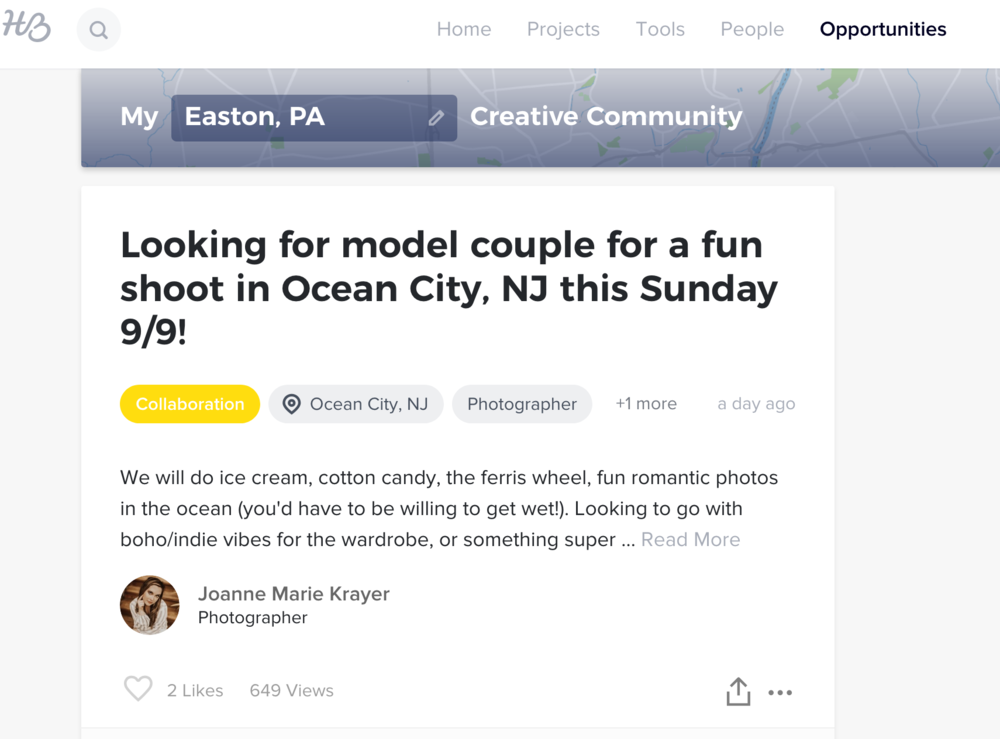
Honeybook has evolved to become a small & private social media platform usable only by subscribers to the platform. It’s not a totally revolutionary concept, but it is quite interesting in practice – and has a lot of potential to become something really beneficial for creatives like ourselves. Often, there will be posts putting out model calls, requests for second shooters, and occasionally interesting jobs out there you might just want to get in touch with someone about.
The Opportunities section of Honeybook also enables connecting with other creatives, and growing your contact list in this way. As you should know, the wedding industry (and related industries) relies quite heavily on referrals and word-of-mouth, so any way to grow your network is a good thing.
Ultimately, this section of Honeybook is what you make of it. We haven’t had a real use for it ourselves, though we do occasionally browse some of the posts in there. We are planning to put out a model call during the winter months when things slow down for us, so we’ll have to update this down the line when we are able to see the results 🙂
Final thoughts
Honeybook is an excellent CRM platform that has the ability to streamline the work you are doing. Honestly, sending contracts and getting paid are the more boring aspects of our job as photographers – but they are necessary things we have to do to keep ourselves protected and, well, not totally poor. Seeing as these are things we need (and you need them too as a business owner) – it’s better to put out a little money in exchange for all the time savings and the ability to better satisfy our clients by having a simple booking system.
If you are considering Honeybook for yourself and want to try it out, please do so through our link. There is no obligation, but if you do decide to ultimately subscribe – you will get 50% off your first year’s subscription, saving you $200 right out the gate!
Have any other questions about Honeybook? Ask away in our comments below!
Check out our new businesses updated review of Honeybook.
